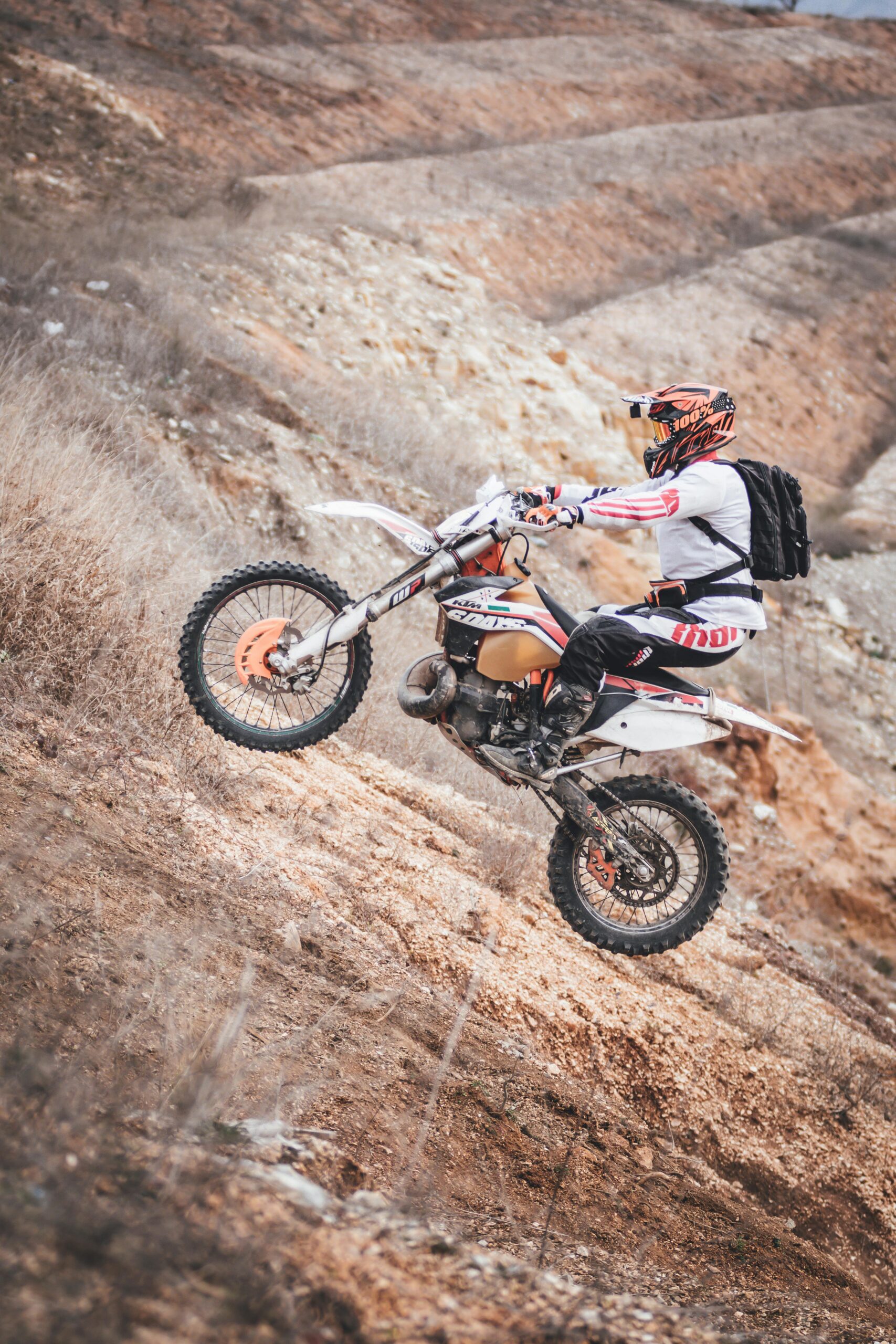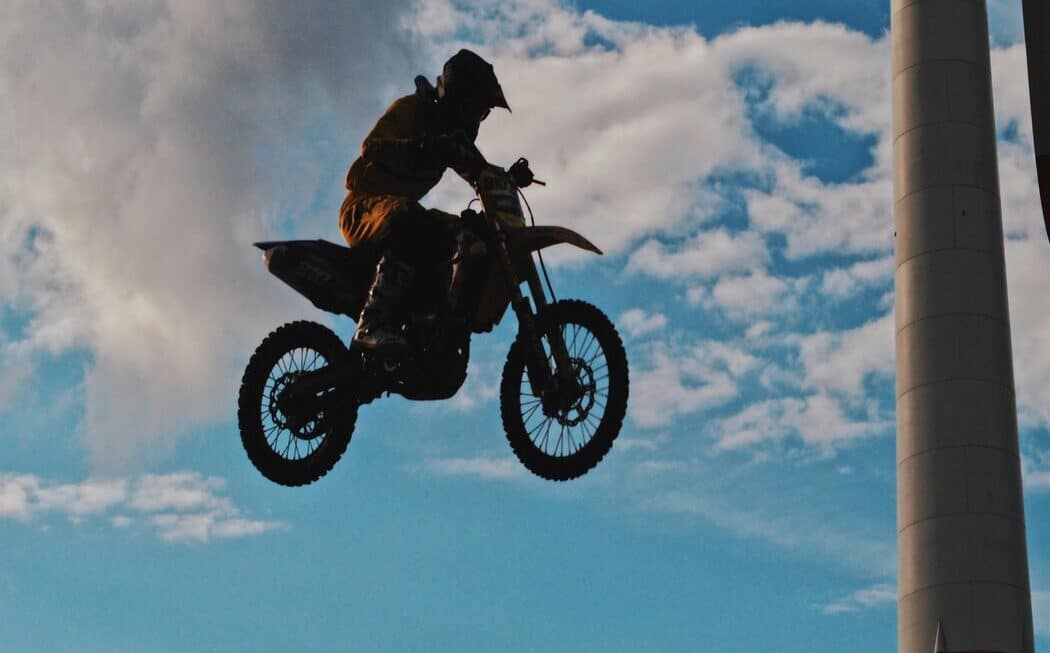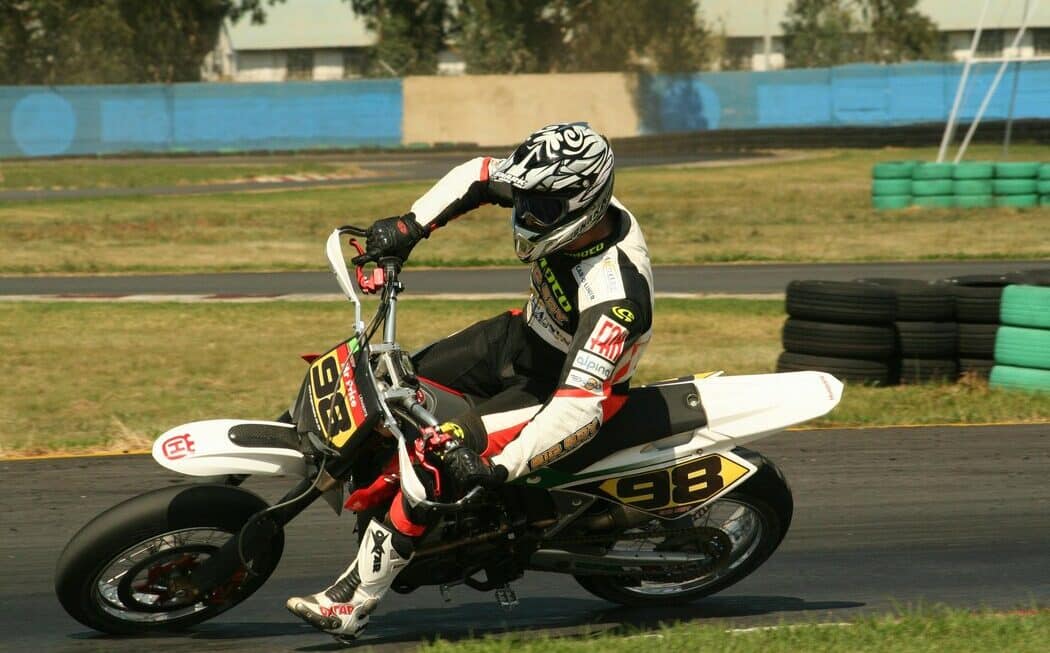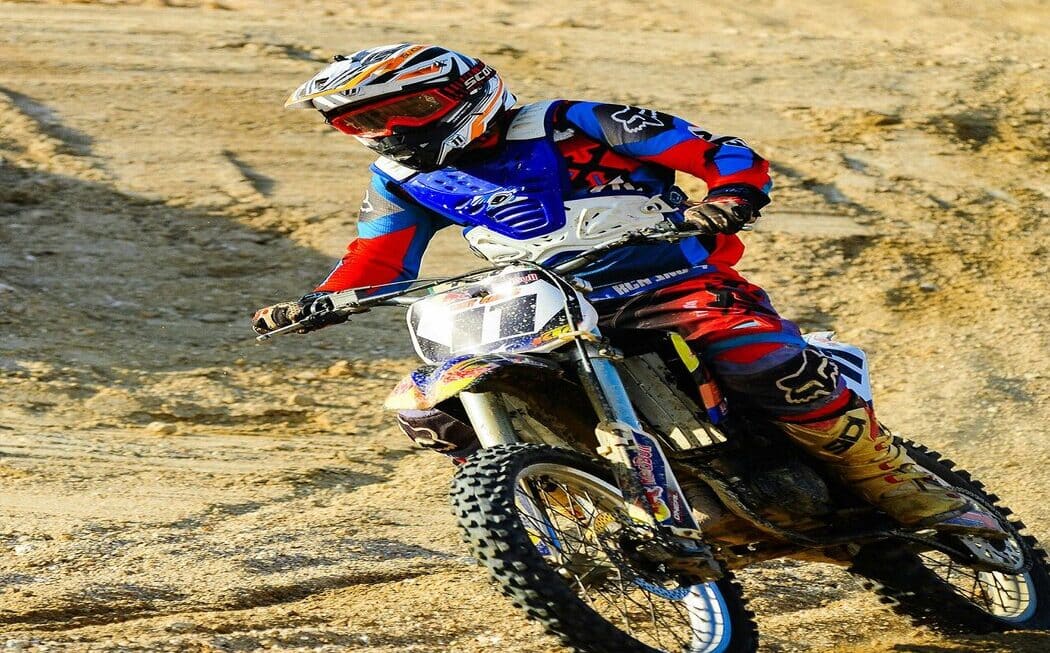Dirt bike riding is a thrilling outdoor activity that pushes your adrenaline to the max as you take on dirt patches and slopes like an off-road champion. You need to have the right setup if you want to get the most out of your biking experience, which includes having spare parts available. This way, if something breaks or stops working then you can replace it quickly and continue your ride without any delays.
The Anatomy of a Dirt Bike :
The parts that make up a dirt bike and their purposes are important to understand when customizing or replacing them. For example, the kick-start lever is used for starting the engine, while the seat helps keep you in control of your ride. Other components include handlebars for steering, shocks for absorbing impact from bumps in the road, and tires for traction. Knowing what all these parts do and where they go will save time and energy when making repairs or adding customizations to your bike.
Engine
Dirt bike engines come in a variety of sizes and configurations, from the small 50cc two-stroke to larger 500cc four-stroke engines. The two-stroke engine is characterized by its quick-revving power delivery and simple design, while the four-stroke offers increased fuel efficiency and a quieter ride. As dirt bikes are more often used for off-road racing or recreational trail riding, many riders choose to modify their engines for increased power and performance.
This can include upgrading the full exhaust system, installing an after-market air filter, jetting the carburetor or tuning with an electronic fuel injection system (EFI), replacing clutch plates, changing camshafts, and adding big bore kits to increase displacement. These modifications enable greater range when tackling difficult terrain as well as increasing peak performance capabilities under duress. Some riders even opt to replace entirely built engines with high-performance alternatives for a complete revamp of their off-road experience. Dirt bike enthusiasts often find great joy in tinkering with their engine components to create custom rides that exactly meet their needs and preferences.
Chassis
The chassis of a dirt bike is its skeletal framework and is a crucial part in allowing the machine to stay together while taking off-road terrain. It serves as the backbone of any dirt bike, consisting of the frame, front fork, and suspension components. The frame’s primary purpose is to link all the other parts together into one sturdy structure and to reduce damage from impacts. Meanwhile, the front fork and suspension are responsible for cushioning bumps and enabling precise steering handling.
The dirt bike’s suspension plays a major role in helping riders handle rough rides. The damping shocks, commonly placed in the frame or near tires, help absorb shock from jumps, drops, and bumps by greatly reducing jarring forces as they travel up the wheels toward the rider’s body. Adjustment spells more control on different terrains when it comes to stiffness and spring rate that backs up speed-critical settings like preload must also be adjusted properly for a smooth ride that will keep you comfortable even on uneven paths. The chassis functions harmoniously with many other parts when it’s in operating condition creating an enjoyable dirt bike experience overall.
Shock Linkage Bearings
Shock linkage bearings assist in providing smooth and efficient operation to the bike. Although they are typically hidden inside components, without them, the suspension would be quite unreliable. The shock linkages take on a heavier load than other bearings found on dirt bikes such as the steering stem and swing arm bearings, and are constantly being exposed to dirt of all types during riding. For this reason, they need regular maintenance such as cleaning and lubrication to remain functioning at their optimal level.
Fitting new shock linkage bearings can considerably improve the performance of a bike, increasing its efficiency and allowing for more precise movement of the suspension system. A particularly hard landed jump or crash can cause damage or even breakage of these important parts – it is thus important for any dedicated biker to keep a close eye on them, examining them carefully after each ride to check for any signs that may indicate potential issues. Investing in good quality shock linkage bearing sets should be something worth considering if you aim to experience the maximum benefit from your riding sessions.
Brakes
Brakes are an essential part of any dirt bike, as they provide critical control to the rider that allows them to stay safe when traveling through challenging motocross tracks and trail-riding environments. Depending on the model, dirt bikes can have either drum brakes or disc brakes, each of which has its advantages and disadvantages.
Drum brakes, located inside the axle, apply pressure from within to slow down the bike. They tend to be lighter in weight but require more effort when pushing on the pedals to activate the stopping power. Disc brakes meanwhile use a pad attached to the outside of the wheel hub which is applied when slowing down and negates some of the physical strain seen with drum brakes. In addition, disc brakes allow for greater precision when it comes to braking force as they provide smoother and more responsive stopping power that can be useful in tense situations on bumpy terrain.
Piston
The piston is a vital component of the dirt bike’s engine. It sits at the top end of the cylinder and is held in place by an outer casing or sleeve. When combustion takes place, gas and air expand inside the cylinder head, pushing down on the piston which is connected to a crankshaft. The piston then transfers energy from this expansion downward into motion which powers the engine.
The construction of a piston consists of strong metallic components designed to maintain its integrity regardless of pressure exerted from combustion during high RPMs. Typical materials used for pistons are aluminum, cast iron, and steel alloys; depending on their use and desired qualities such as heat conduction, durability, strength, etc.. Furthermore, they have what is called ‘rings’ which help maintain compression within the cylinder though not allowing any gases to pass between the wall of the cylinder and the face of the piston themselves.
Suspension
When it comes to dirt bike suspension, the most important components are the inverted forks and shock absorbers. The inverted forks are usually mounted to the frame’s steering head via triple clamps, while some older models might have a right-side fork instead. These forks tend to include both compression and rebound adjustment options that can be found on one or both fork legs. To further adjust the suspension, you can slide the fork tubes up or down in their triple clamps.
The shock absorber of your dirt bike is typically linked together with other parts and attached to the swing arm and frame. Adjustments linked with this component involve spring preload, low-compression settings, high-speed compression, and rebound ratio. With a limited budget for setting up your suspension for different tasks you face when riding off-road, you can make changes yourself to improve its performance.
Valves
The valves of a dirt bike are a vital part and should be kept properly adjusted for it to operate efficiently at all times. Failure to do so could lead to engine issues, as well as reduce the performance drastically. It can also cause the bike to suffer from a lack of power, misfires, or delayed responses. Therefore, riders should be extra vigilant in ensuring that their valves are regularly serviced and adjusted accordingly.
Adjusting the valves involves removing several parts from the dirt bike, including the cylinder head cover, valve cover, and camshafts before one can check for any clogged or worn-out parts. If you seem to experience an unusually high number of issues with particular part/parts then you must reach out for help from an experienced riding instructor or up your maintenance schedule to ensure all parts remain functional. In addition, proper installation of each component might also prevent further technical difficulties due to faulty assembly.
Wheels
Dirt bike wheels are a critical part of their design and must be able to handle the stress of uneven terrain. Consequently, they have specially designed tires with tightly spaced tread blocks made from softer rubber than is used on standard road bikes. This allows them to move ahead and grip into packed earth and other difficult surfaces. The paddle-tread sand tires in particular are popular amongst dirt bikers for maximum grip and efficiency when driving across sandy terrains. In between the soft and hard tires, intermediate types are also available, balancing some degree of traction with more durability.
Wheels often face immense stresses on dirt bikes as they travel over uneven ground, potholes, stones, sticks, mud, or sand. Despite this huge force placed onto the bike and its parts, modern dirt bike wheels remain surprisingly durable if they are appropriately taken care of by periodic inspection rides checking for any signs of wear or breakage that might jeopardize safety or performance. It’s important to remember that no matter how durable your dirt bike wheels prove to be they need to be checked periodically for any potential fractures or significant wear as leaving these problems unchecked can cause serious problems down the road.
Tires
The tires of a dirt bike play an integral role in the performance and safety of the bike, especially when riding on difficult terrain. As compared to Regular Street bikes, dirt bikes have a wider variety of tires available made specifically for off-road conditions, such as mud, sand, and rocky surfaces. These high-grip tires feature rubber on the external surface which allows for better contact with the terrain. This type of tire also helps improve stability while cornering or navigating deep ruts or mud pits.
In addition to their improved grip relative to street bike tires, dirt bike tires also feature treads designed for superior drainage. The combination of mud displacing and aggressive treads helps ensure that your bike stays upright even when traversing bumpy roads with low maneuverability and traction. Such methods also help keep dirt from building up in the cracks between tread sections which can cause them to wear out faster than expected. Furthermore, some all-terrain tires have knobs at the edges that allow you to ride on paved roads if needed without affecting their performance too adversely. All these features contribute towards making dirt bikes one of the most capable machines for off-road racing and adventure biking.
Final Drive
The final drive system of a dirt bike is one of the most important components as it acts as the connection between the engine and the rear wheel. Generally, there are three main types of final drives used in dirt bikes: chain, belt, and shaft drives. The chain or shaft-driven option connects the engine’s output to an axle located at the rear wheel. Through this strong connection, power is then transmitted from the gearbox directly to the wheels with maximum efficiency.
Chain drives typically provide more torque than either a belt or shaft drive, making them well-suited for extreme off-roading conditions found in motocross and super cross racing. Other advantages to chain drives include moderate cost compared to other drive systems as well as great strength and durability. Belt-drive systems are quieter than conventional chain drives; therefore, they are often preferred for trails when less noise is desirable. Finally, shaft-drive systems offer smooth control on any terrain due to their ability to move rotational movement directly from the gearbox back to the rear axle at the end.
Crankshaft Bearings
The crankshaft bearings are a crucial part of the bottom end of any dirt bike engine. These specialized bearings help support the action of the rotating crank as well as reduce wear and tear on other components in the engine. They can also keep all parts running smoothly by providing consistent lubrication and maintaining the distance between different parts. However, these bearings are exposed to immense stress as they have to handle large amounts of heat, friction, and power. Dirt can easily move into their tiny spaces, causing them to wear out or seize up over time.
If crankshaft bearings become damaged or fail altogether, it hurts the entire engine system. When they seize up, this leads to broken crankshafts or internal rods that must be replaced for the performance of the engine to improve. Maintenance is key when it comes to keeping your dirt bike running as it should; cleaning and lubricating your crankshaft bearings regularly is essential for reducing repair costs and extending its life span. Additionally, regular visual inspections should also be done to ensure they are properly lubricated and functioning properly before each ride.
Conclusion
In conclusion, riding a dirt bike offers numerous advantages as compared to riding a motorbike. It requires fewer skills than a regular motorbike and is much safer as obstacles are usually not present in off-road terrain. The experience of riding a dirt bike will similarly help build confidence and comfort when you move up to a larger motorbike. Furthermore, the feeling of biking across different parts of the country or state borders can spark wonderment and motivate further exploration of the dirt bike.
Therefore, it is evident why many skilled riders initially started by riding dirt bikes – it has become increasingly popular over recent years and offers plenty of experiences for anyone passionate about it. As long as appropriate safety equipment is always worn while riding, risk levels are considerably lowered and more adventure can be enjoyed on your ride!



